#elvhenan
Text
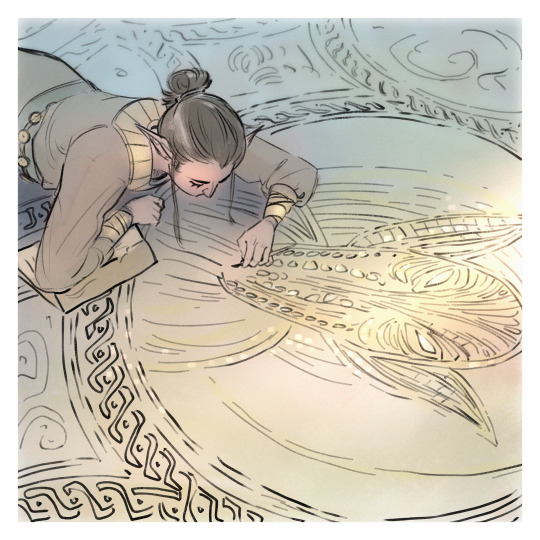
Elgar'nan's temple workers duties
238 notes
·
View notes
Text
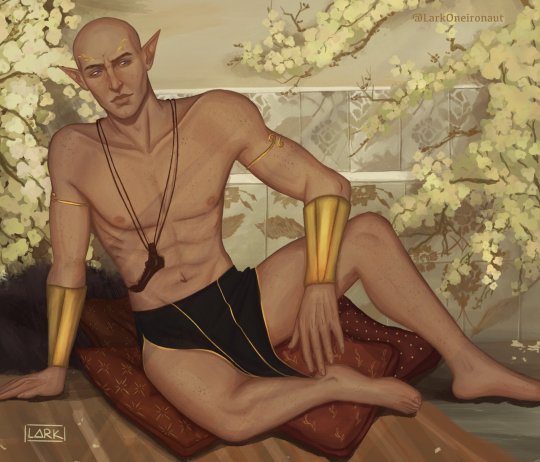
Even the Dread Wolf of Arlathan needs a lazy hour in the summer heat, despite the rebellion
Inspired by Conrad Kiesel's Manuela (1884)

#dragon age#bioware#my art#da4#dai#dragon age inquisition#solavellan#solas#dread wolf#fenharel#dragon age dreadwolf#Arlathan#Elvhenan
404 notes
·
View notes
Text
there's like, things about Dragon Age and the ancient elven empire there that I don't believe can quite be grasped unless you have a cursory understanding of either Tolkien or the Tolkien-generated trope of elves as an advanced civilisation of superior beings with magic/technology/knowledge/lore that is now lost and/or that largely influenced the remnants of the human empire, which substituted the elven one as the leading force in the continent. fantasy worlds like Dragon Age are deeply in conversation with that (and I guess like the Witcher or smth but I never read or played that, and didn't finish season 1, so my knowledge is second-hand; but either way).
the thing in Tolkien and Tolkien-generated tropes is that these elves are good. they're superior, they teach things to the second-coming races, they're narratively exalted, they're borderline divine, any kind of more or less violent colonialism (it happens) and feudalism (also happens) they instate is good, narratively obfuscated, or even justified. Tolkien has criticism of colonialism in his work, but rarely if ever goes all the way when it comes to elves. criticism of elven hierarchies based on clan and level of holiness and greatness are often narratively undermined (e.g. Eol, a character whose criticism of Turgon and the Noldor is diluted by the fact that he's awful as a person)(you can go into detail about Galadriel and Nimrodel but this post is technically a Dragon Age post lmao).
there's a Tolkien paper called "The Wretched of Middle Earth: An Orcish Manifesto" by Charles Mills, which goes into scathing detail about how the narrative sets up the elves as a superior race and consistently characterises the other groups, orcs, humans, dwarves, as racial inferiors. it's not afraid to call out "aryan" comparisons, without trying to argue that Tolkien actively believed in that ideology. the racial herarchy is there, in the text.
tl dr elves have all the rhetorical trappings of an empire... without ever being one. they're good, they're paternally helpful towards the humans they educate (who are therefore the superior humans), and they're good also and particularly in the sense that they never "fell" in a religious sense, no matter their individual actions (fastidious details and contradictions notwithstanding). they didn't abandon the true god.
what's happening in Dragon Age is that these elves, who are narratively presented as the "true" elves, the lost ideal, the immortals before modern elves turned from their ways and lost that immortality, the great advanced civilisation that probably taught humans before humans feasted on their remnants, these elves... are an empire. they conquer, enslave, pillage from the dwarves (another trope turned on its head; don't tell me the dwarves-elves peaceful companionship where the dwarves keep digging to satisfy the demand of material but they're also best friends with elves, turned to explicit war of conquest for possession of raw material in Dragon Age, doesn't elicit mithril-lyrium comparisons), have pantheon wars. this is the sole logical conclusion of those tropes. it's the subtext, the unspoken, the unspeakable, brought straight to light. it's the rhetoric of empire that's been buried in stories about elves brought to its only possible sensible end: this is an actual empire. there's no way it could have been anything else.
(this goes deeper with the numenor-gondor-tevinter comparisons, which are absolutely blatant when you know that gondor's precursors, numenor, went full empire, and that their last action before the island sank was attack the elves' blessed realm. if ar-pharazon and numenor had won, we could have gotten something very similar to Tevinter in storyline. only the Tolkien racial hierarchy simply cannot be toppled like that, it's practically divinely mandated and protected. the maker-the allfather directly and personally intervenes. but without this extremely disruptive and literal deus ex machina, that too is turned on its head in Dragon Age: it's not god who sinks the capital of the human empire to prevent their violent conquest AND traps the fighting humans underground, after the elves have fled instead of choosing to fight; it's humans who arrive, the elves flee, and then humans presumably sink the capital city into the ground. once again, when the ontological hierarchy of races and the divine decree of goodness and favour is removed, the true logical conclusion comes to the fore. one empire substitutes the other.)
#Dragon Age#The Silmarillion#I honestly think the choice of the elvhenan empire#built on decades-long tropes of fantasy and elves#is sheer genius#Elvhenan#JRR Tolkien
285 notes
·
View notes
Text
There’s something shady going on with the Chantry, guys...
...apart from the endless abuses of the rights of mages/elves/states’ sovereignty, I mean. I am currently working on the textures of the Inquisition Chantry robes for a mod, and I couldn’t help notice this decoration on the cleric robes looks and how suspiciously like “Moonhead” from the DA:D teaser images it looks:

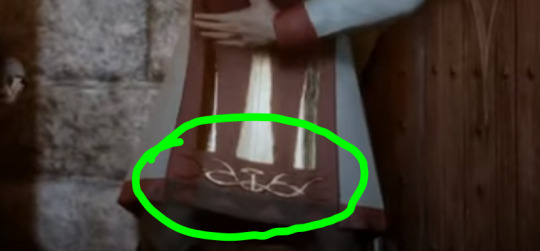
There’s not just the obvious crest, but even stylised tentacles. And after the latest mural it is a given that Moonhead is an Old God... one of those gods that Andraste was allegedly waging her war against?! So why is THAT on the uniform of the faith she started?

And then, when I was looking for a picture of the statue on the right, Google showed me this, and now I’m just screaming:

What the actual fuuck?! This isn’t really a theory tbh, just me going slightly insane at possible implications of this...
WHAT THE ACTUAL HECK?
...
And that’s not even getting into how the sun burst is the Chantry’s own symbol but there’s again an Old God who also has it as theirs?

Or whatever this is supposed to mean, idk:

What does it all mean?????
I wanna hear people’s theories - please! Make it make sense!
#Dragon Age theories#my theories#dragon age#dragon age inquisition#dai#evanuris#old gods#mythal#andraste#meredith stannard#chantry#elvhenan#moonhead#dragon age dreadwolf#da:d#da: dreadwolf#dragon age symbolism#dragon age meta#trespasser#dragon age trespasser#trespasser murals#bride of the maker#da4#da4 speculation#dragon age speculation#chantry critical#FUCK THE CHANTRY
246 notes
·
View notes
Text
I have this headcannon that the veil weakened the elves significantly that’s also the reason why half elven children don’t look like their elven side. The veil has caused the elves to loose vital “nutrient” for them to grow well. That’s the reason why ancient elves are so much taller in comparison to modern elves.
#dragon age#dragon age inquisition#elves#dalish#elvhen#elvhenan#dragon age origins#dragon age 2#dragon age inquisition trespasser#ancient elvhenan#elf#fenris dragon age#solas#solas dragon age#solas dai#zevran arainai#veil#the fade
79 notes
·
View notes
Text
Dragon Age Iconic Patterns: The Sun

In this post I will try to extensively gather all the sun-based or sun-like imagery that we find in all the games of Dragon Age. From the most typical ones to those which may seem obscure or with a hidden allegory/design. I will qualify their resemblance with the Sun symbol as Strong, Weak or other.
This post contains the following symbols
Chantry Sunburst
Elvhenan Culture: Sun symbol among the Evanuris
Elvhenan Culture: Asterisk Symbol and Elvhenan Doors
Elvhenan Culture: Golden Ring
Elvhenan Culture: Crappy Sun
Elvhenan Culture: Elgar’nan and Sylaise
Elvhenan Culture: Murals
Tevinter Culture: Green Star
Tevinter Culture: different decorative elements
Dwarven Culture: Fairel and Dwarven art
Ferelden Culture: The Sun Face and the geometrical Sun
Grey Wardens and the Sun
Avvar and the Sun
Flemeth
Qunari, Par Vollen, and the Solium Constellation
DAO design
Free Marches Rural Areas
[This post belongs to the series “Analysis and speculation of Statues”]
[Strong] Chantry Sunburst
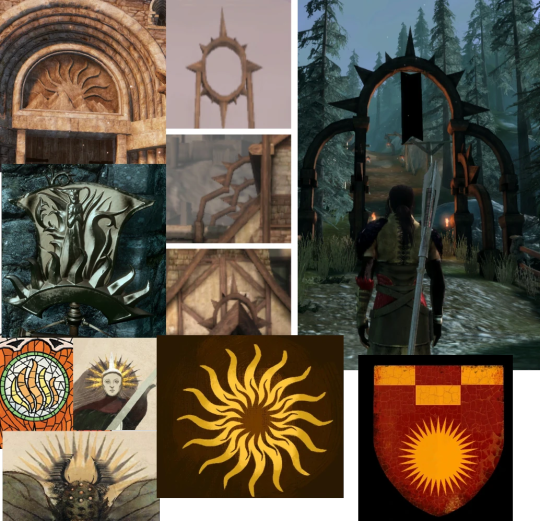
The most typical one that appears in DA series is the Sun or Sunburst with wavy rays, repeated so much along the games that we can identify it immediately. It’s the unequivocally symbol of the Chantry. We found it in many versions, and it represents the “dawn” with the idea of hope and “new beginnings”, but also the fire that “purified” Andraste in her pyre to let her ascend to the Maker’s side. In the posts of Andrastian Art [Andrastian Design: Stained Glasses], we also find that “balls of fire” [which can be interpreted as a Sun in another way] are shown to represent the Maker or the Faith in Him.
Andraste’s single spiked helm seems to be inspired in a single sun ray, at least this is what an illustration in the Chant of Light [book of World Of Thedas] seems to suggest.
In general, most of the representations of the Chantry Sun have 16 rays.
The same sun-like symbol appears in its Tevinter version when we see the Imperial Chantry; the only difference with the Orlesian one is that the Tevinter Sunburst has straight rays.
As a detail, in DAO, we had the typical representation of the wavy sunburst present in some strange devices of Tevinter origin, for example, the ones we found in [Brecilian ruins], while the main Church in Denerim, or in Haven, display spikes that, more than resembling a sun, look like thorns or even a thorny vine. This may be a consequence of an original plan in linking, design-wise, the chantry symbology with the thorny vines that represent the Blight or the Darkspawn [As we explained in the section “Non-mural symbol: Thorny vines” from Murals in DAI: Basics], or merely it was a limitation of the design of the game, as we know DAO suffers from.
We also know that tranquils should display this symbol on their foreheads, burnt with lyrium, but as we saw along DAO, none of them had it. Later we were informed that the devs had problems to add this mark on the npc, therefore, it was never shown until DA2. When it comes to this symbol, it is interesting to see that tranquils carry the metaphor of “a Sun burning their minds and emptying them”, which may or may not be related with Dwarves and their fear to the Sun and potential relatinship of Elgar'nar shoving a fire ball into their underground lands [More details of this concept in Deep Roads [DLC Trespasser]: Lower Walkways in particular with the codex Torn Notebook in the Deep Roads,].
[Strong] Elvhenan Culture: Sun symbol among the Evanuris

Strangely close to the Chantry Sunburst symbol, we find the “half” sun symbol [tagged along the blog as Sun-head creature] in what we suspect was one of the ancient primordial dragon symbols that some Evanuris took over when they claimed Divinity [for more context, read Attempt to rebuild Ancient Elvhenan History]. It’s hard to say which Evanuris took control of this symbol, but we know there is a clearly sun-like symbol present in the Crossroads of the DLC [as a statue, check The Crossroads [DLC Trespasser]: Entrance] and in the Shattered Library [as an Eluvian, check Shattered Library; Entrance and Courtyard]. With the release of the Vinyl, we also discovered and reinforced the hypothesis that this symbol belongs to or was co-opted by an Evanuris [read Speculations about the Vinyl Art for details] thanks to the image of an elf wearing a hat with that shape.
A consistent detail of this image is that it’s a half-sun with exactly 7 rays.
[Weak] Elvhenan Culture: Asterisk Symbol and Elvhenan Doors

If we extend this imagery, and check other symbols that may look similar to a sun, we find the ancient Elvhenan Doors [Elven Ancient Shard-based door], which top displays a pointy sun of 8 rays that may or may not be related to the Asterisk symbols [also related to the Titan’s core, which I talked about in the post of Murals “The Death of a Titan”]. In the way the door gets illuminated when activated also makes us see a “circle” in it that can be loosely related to the “Golden Ring shape”. More details about this ring will be treated below.
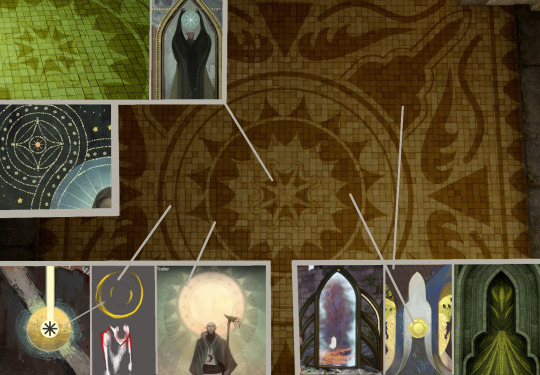
This strange sun on the ancient door also makes us think in the Asterisk Symbol [made of 8 points], which lays at the centre of the yellow mosaic, which may be related to the core of a Titan [asterisk of 8 points too]. The link is immediate when we see that this asterisk is outlined by a shape that looks like a star or a Sun, inside a big ball with triangular-shape ends. This same symbol appears in the last Trailer of DA4, behind Solas, when he is presented like an Hermit, mysterious, apostate mage. Around this “sun” we can make out several concentric lines that may refer to a “Golden Ring”.
The Asterik symbol also appears in murals such as “The Creation of the Veil” or “The Death of a Titan”, which allowed us to relate them with the core of a Titan and its immense power of "making real what you imagine"reinforcing the reality", but this symbol also appears in a corner of Solas’ tarot card.
The yellow mosaic also has some shapes at the four corners that may represent eluvians or something related to Mythal. In the mural of “the Temple of Mythal” from “The actions of the Inquisitor”, we see that Solas draw a particular star of 8 points inside a door frame that resembles this “eluvian outline”, but it’s also the shape of the doors of the Temple of Mythal which represents Mythal herself in her dragon shape. All these symbols seem to reinforce the idea we explored in “The Death of a Titan”: Mythal seems to be related to the core power of a Titan represented by an asterisk that evolves into a golden ring and into a sun.
As I repeated several times in Speculations about the Vinyl Art, at times, we find some hints where stars or balls of fires [also understood as suns] are related to Mythal and Elgar’nan, making us suspect that, maybe, Mythal and Elgar’nan share a nature similar to Falon’Din and Dirthamen’s: apparently, the same creature with two different aspects from them. If this were the case, associating Mythal with the Sun would make sense, and it would also explain why, if Elgar’nan was so central in the Elvhenan culture, there are so few representations and statues of him, while Mythal overwhelms it.
[Weak] Elvhenan Culture: Golden Ring

During the last trailer of DA4, we see Solas turns into the Black Dread Wolf as a sun in the background becomes a moon [single golden circle] and later, it separates itself into concentric rings, that may or may not be related to the “Golden Ring” so deeply entangled with Elvhenan culture. Thanks to this imagery, we may relate the Sun to the Golden Ring [specially if we consider that the mural presented in Nation Art: Elvhen displays the yellow ring in a position that may be considered “the sun”, but also the "authority/power above"]
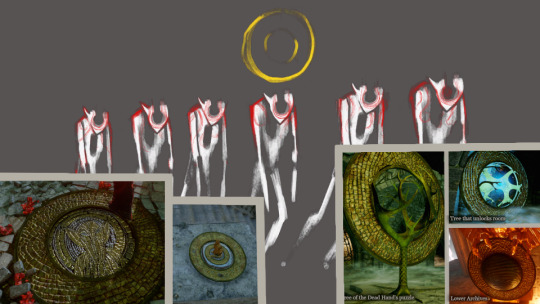

We need to remember that the Golden Ring’s presence is always associated with control, power, and occasionally to Mythal and Dirthamen. In the mural of the “zombie elves”, it’s above all of them, and due to this position, it could be interpreted like a “sun” or moon upon the controlled, zombified elves. But I’m not too convinced in this interpretation, since we already explored in posts such as: Nation Art: Elvhen, Exalted Plains: Ghilan’nain’s Grove and the Dead Hand, DLC: Jaws of Hakkon - Frostback Basin, Elvhen Tomb, Ancient Elven codices; Fen’Harel’s mountain ruins, The Crossroads [DLC Trespasser]: Elven Mountain Ruins; Vine-covered Tower, Murals in DAI: The Death of a Titan, and Speculations about the Vinyl Art that this ring was more related to control, power, or even forced change/shape in some cases. Due to its power or potential knowledge, it's also associated to Dirthamen Owl [which also could be Andruil's owl according some inconsistencies in the same Unreliable Dalish legends].
On the other hand, it’s never clear if this symbol may have morphed into a sun along the ages with the loss of memory that the Elves had throughout generations when they lost their immortality. However, I tend to consider that this Golden Ring may have changed into a Sun when it entered in contact with human groups, in the same way that I see the story of Fen'Harel gave enough context for humans to create the Maker myth based on him, potentially during the time of Halamshiral [for more details, read The Chantry and the Mythology of the Chant of Light]
This ring also appears in the last scene of DAI, when we defeat Corypheus, showing Mythal inside it, as bits of red lyrium sprout around it. This can be related to many speculations done in Speculations about the Vinyl Art, where we can conclude that another fragment/part of Mythal is still trapped in the Black City, corrupted, and contained by an immense power that may have been used before by the rest of the evanuris to control their own people.
The Golden Ring has also been seen enclosing Elven Tree Statues and Elven Orbs, implying its relationship with elvhenan power and/or Mythal’s [after all, we know that Mythal took the power from a Titan from which elvhen orbs were developed, and trees are also her symbol, according her vallaslin]. It's worth noting that the only working orb we saw in the game was Mythal’s, so far.
[Weak] Elvhenan Culture: Crappy Sun
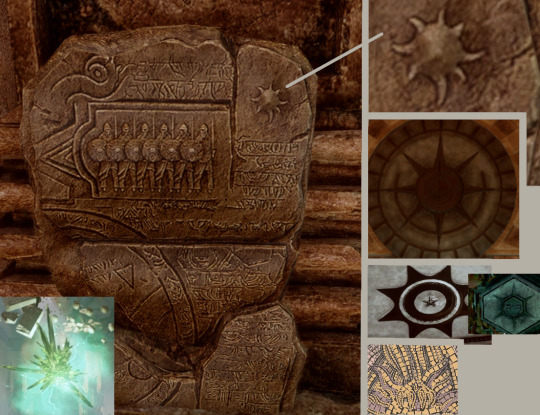
There is also a strange symbol that I called “crappy sun” in the ancient tablet we find at the entrance and deep into the tomb of Forbidden Oasis: Solasan Temple [along this blog I’ve tagged it as “Stone in Razikale-Ceremony-style”]. It’s hard to say if it represents a sun or a breach. It may be related to a sun similar to the one of the Elven Ancient Shard-based door that, later, Tevinter co-opted to turn into the several versions of pointy suns we see in Tevinter Pre-blight ruins, [let’s remember they were not Andrastian yet, and still they had this symbology in their buildings and elements because it may have been related to ancient dragons, or taken from another elvhen symbology during the time of the Dreamers since there are some proofs, such as the Tevinter Mosaic [Invasion], that may show that Tevinter had a better relationship with elves back then].
Maybe the original symbol was related to Elgar’nan, as we see in his mosaic, where he shoves down the sun into the earth, and its rays are wavy and a bit “crappy”. If this relationship is correct, maybe what Elgar'nan shoved into the Earth to destroy the dwarves/Titans was not a sun but a breach? Again, a very unlikely hypothesis.
This “crappy sun” also has 8 rays.
[Strong] Elvhenan Culture: Elgar’nan and Sylaise
Elgar’nan’s mosaic was interpreted in the post Evanuris, and basically shows an elf shoving down a Sun of wavy rays into the Earth. It’s easy for us to relate this image to the unreliable Dalish legend of Elgar’nan [read Elgar'nan: God of Vengeance]. Elgar’nan is presented here as the son of the Sun itself, who tried to burn all life on the Land out of Jealousy, so Elgar’nan vowed vengeance against his Father’s cruelty, and his rage won against the fire of the Sun. Then, “Elgar'nan threw the sun down from the sky and buried him in a deep abyss created by the land's sorrow.”
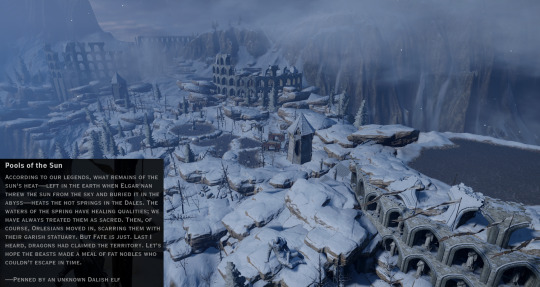
This story can be followed later in the post Emprise du Lion: Pools of the Sun, where we find another unreliable Dalish legend claiming that this place has spring waters because it was here where Elgar’nan shoved the sun into the Earth. I also made a link to Sylaise considering the Elvhenan arenas we can see in this region, the presence of Sylaise’s Shrine, and her thirst for being always competing with someone. These details can make us suspect that this Sun could have been Sylaise [so deeply related to fire, the sun, and also as angry as Elgar’nan according the Song to Sylaise].
It’s very worth noting that these two legends, said by different clans, claim that Elgar’nan pushed the Sun into the Abyss. Another detail we have to assume is that "Abyss", "Beyond the Deep Roads" and "The Void" seem to be one thing related to the places where the Titan sleep [or even inside the Titan themselves] instead of a strange dimensional pocket we never saw before. This links the Elvhenan with the Dwarven in what we speculated in Murals in DAI: The Death of a Titan.
With this relationship, we see again the Sun as a weapon of destruction and control.
[Weak] Elvhenan Culture: Murals

Murals present a red sphere with rays that may imply a Sun .
In the mural “The Creation of the Veil” [1], we find a red sphere inside a black one, making us suspect it’s the big evil released by the Evanuris that Solas isolated with the creation of the Veil. Around it, there are seven “bubbles” with similar “rays” in grey and golden colours that may imply “gates” that would allow us the access to the central “sun” or red sphere.
In the mural “The Death of a Titan” [2] we talked extensively about the asterisk symbol, its representation of a Titan’s heart and all that power associated with it, as well as with Golden Rings. The codex in here speaks of a red sphere that contains fury, and maybe all of this can be related to a sun, or better said, the other way around: a Sun as a sphere of fire, related to fury, and buried below underground to contain its destruction. This also brings us some similarities with the unreliable Dalish legends about Elgar'nan.
In the mural “Red Lyrium Idol” [3] we also commented how the image looks as if Solas were walking on a sphere of fire. It may be related to the red lyrium idol too. Here, we keep linking this idea of a “sphere of fire” as a potential Sun.
In the murals of “The actions of the Inquisitor” [4], we see several times that the red sphere associated with the big evil isolated behind the thick, impenetrable barrier of the Black City seems to be positioned in places that may allow a soft interpretation as a “sun”in the sky.
These symbols seem to gather more importance as we analysed the Vinyl Art, where we find the concept of the Eclipse [as an ominous symbol of Fen’Harel that covers and hides the Sun] and a lot of iconography of stars, which can be interpreted as “suns”.
[Weak] Tevinter Culture: Green Star

Pre-Blight Tevinter art has a “star” symbol that may be interpreted as a sun, specially if we consider that the inside of this green star displays the symbol of the elvhenan Golden Ring in red colour. However, it seems more likely to be a symbol representing the power that one can extract from the Breaches. The green colour helps in this interpretation and puts it a bit farther away from a sun interpretation than other symbols. However, it keeps linking the Golden Ring with the power of creating a Breach.
[Confusing] Tevinter Culture: different decorative elements
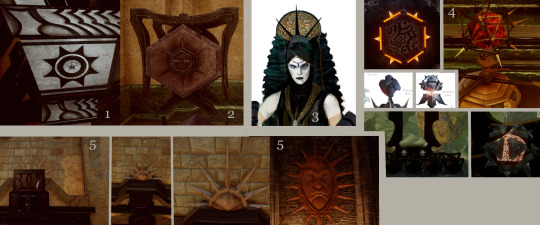
The rest of the symbols in Tevinter objects may have some relationship with the Sun. For example, we find doors, boxes, and columns decorated with an 8-pointed star [1] but we also find another one with 6 points in something that looks like a box [2]. The shape of an “hexagonal” sun of 8-pointy rays can be found as well in objects like the “scrying orb” [4].
Among the outfits, we find a 3-ray comb used by Tevinter women [3], which may be related to the sun-based symbol of an Old God [and potentially related to the corresponding Evanuris associated with it]. This symbol is a lot closer to the "Sun-head creature" we found among Elvhenan objects.
As a curious one, I will always point out the strange, hidden Sun figure that belongs to the Free Marches decoration that can be found at the entrance of the Inner Sanctum in Western Approach: The Still Ruins, Viridis Walk and Inner Sanctum.
I think it’s clear and safe to say that most of the sun-based symbols present in Tevinter culture [and previous to their conversion to Andrastian religion] may have been originated from the contact with the Elvhenan [during the Dreamer time where we can see less repulsion to Elvhen according the Tevinter Mosaics] or [most likely] with the dragons that may have been related to the Elvhenan, as I made the connection in the comic post The Missing.
[Weak] Dwarven Culture: Fairel and Dwarven art

The Dwarves, at least the ones in the Fairel’s ruins, may have some link with the Sun as well. In these ruins we find the same exact stone tablet we find in the Ancient Elvhenan tombs [1], which displays the “crappy sun” I commented above. Once again, it could be a sun but also a breach, so there is no much sense to keep focusing on it.
Another symbol to relate the Sun to the Dwarves may or may not be an old “Dwarven stone-paintings” we saw since DAO, which basically shows a dwarf working the stone [3]. Based on symmetry, we could assume that the triangles on the background are stalagmites, but if we stretch-out this interpretation, they could even be seen as a sun with its rays. It’s very unlikely, since it seems to be more a design resource to highlight the scene of the stone-painting, but for completion’s sake I think it’s worthy to keep it commented here.
However, this simple design allows us to interpret it in different ways: the spikes we see can be pieces of rock protruding from the ground and the Dwarf in it is mining them [as its original codex in DAO seems to imply], but also it could be understood as a quarter of a Sun peeking through the corner of the image as a Dwarf works tirelessly.
Later in DAI we are introduced to another piece of art of similar characteristics [2]. The building was never possible to be identified unequivocally, and in posts like “Architecture of Kirkwall : Gallows and Lowtown/Darktown” I related it to representations of Kirkwall or cities that may be similar to Kirkwall where the runecraft mastery of dwarves was used [and probably, it was a source of pride for these clans, who may have kept the achievement immortalised in a piece of art reproduced among the noble dwarven families]. This piece also shows a background very similar to the one in [3] that may be a representation of stalagmites or a sun, if it’s stretched-out enough.
Another strange symbol in the dwarven furniture is the one presented in some stone-seats: an elaborated metal image that shows thorny vines on or over a sun [4]. This symbol appears in many other parts of the game where there are dwarven rooms, but also in Arbor Wilds :Cradle of Sulevin where we can read the Vir Tanadhal, However, in this case, the symbol is not completely the same one than in the Hissing Wastes: Fairel tomb.
It’s hard to suspect if this is a mere reuse of assets, it has a lore-related meaning, or it’s just a reflection that the Dwarves and the Ancient Elvhen had a relationship quite ancient [as it shows the Elvhen tree and its dwarven, more geometrical style, that I’ve been pointing out since DAO in Orzammar]. We have to remember that the Ancient Elvhenan saw the dwarves as soulless creatures, workers of the “pillars of Earth” and worthless. However, I always claimed it was never clear if this was a reference to ancient Dwarves that were linked to the Titan deeply to the point that they became Sha-Brytol after the break of the link, or were related to more independent dwarves as the ones we see now, who have a sense of Stone, but can’t understand the Titan with the exception of some gifted ones [such as Valta].
Finally, the dwarves have an additional aspect related to the Sun in the very unreliable codex called Torn Notebook in the Deep Roads, Section 2. I wrote about this codex in a more integral way in Deep Roads [DLC Trespasser]: Lower Walkways. But basically an ex-Dalish elf [now a Qun converted] relates Elgar’nan’s fire [which another unreliable Dalish legend, Elgar'nan: God of Vengeance, claims he shoved the Sun into the Earth] to the fear to the Sun that Dwarves experience [Read the section Elgar’nan and Sylaise above]. This may have been a Dev’s choice to makes us aware that there exists a relationship between the Sun and the dwarves, even though there is no lore material that can make it clear enough.
[Strong] Ferelden Culture: The Sun Face and the geometrical Sun

In the Tryptich presented in Andrastian Design: Tapestry and Tryptich, we find three symbols on top of each part of the scene: the six-snakes that represent Tevinter, the golden city above all the image representing the Maker or the Chantry Religion, and over the section of Ferelden/Orlais chantry, a 8-pointed sun which rays look like triangles. Once again, the resemblance of this symbol with the elvhenan sun in the mural “Temple of Mythal” is remarkable [check the Temple of Mythal in “The actions of the Inquisitor”] or the sun shape in the elvhenan yellow mosaic or in the background of Solas in the Trailer of DA:D. This could come from different roots:
1- An Orlesian root, considering how much of the elvhenan influence it had during the time of the Halamshiral and the coexistence of humans and elves in the Dales for some years [to the point where inter-racial families were made, as it was hinted all over the Exalted Plains]. I spoeculated how the idea of the Maker may have been developed during this time in the post The Chantry and the Mythology of the Chant of Light
2- Another potential root is related to the Alamarri root, and therefore, linked to the Avvar: this sun may be a representation of the Lady of the Sky for the same reasons I will explain below in the Section Avvars and the Sun.
We can find similar icon in the book World of Thedas, where they show a unique Ferelden Tryptich [3], which top displays this symbol with a sun that even may have a shape of a Golden Ring within it. In either case, we know that this symbol later was part of the Ferelden Chantry, which sun is very pointy, as DAO showed it [see the first section in this post: Chantry Sunburst].
In DAI, we find in some small towns of Ferelden, a unique strange Sun with a crying face [1]. On it we see a bird and a squirrel. It’s hard to know exactly what this is, [check the post Nation Art: Ferelden], but maybe it can be understood as a representation of Andraste made by Ferelden culture mixed with some local animals and fables created as a mixture of cultures, similar to the tale that related Wyverns to Andraste [check the wyvern section in Dragon Age Iconic Patterns: The single spike].
There is also a fish drawn in the DLC of Hakkon on a fisherman shack [2], which displays a pattern that can be related to the “crappy sun” designs on its skin. Not sure what to make about it. The closest is that the Avvar represented this symbol as a way to reflect what they may have seen in the Isle of the Lady, where a big ancient breach have been there, open, since the time of Telana [read about this in “The Veil and the preservation of the Waking World” from the post Frostback Basin [DLC]: Miscellaneous ].
[Strong] Grey Wardens and the Sun

The typical symbol of the Grey Wardens involves a chalice that represents the Joining ritual. It always displays a Sun, and not any sun: it’s one with a strong resemblance to the Sunburst of the Chantry. Let’s remember that the Grey Wardens was and is an independent Order that doesn’t respond to the Chantry, and even more so: it was created before the existence of the Chantry, and before Andraste was born. So any quick explanation that this sun is present in this object due to some potential influence from the Chantry seem unlikely.
However, as I showed in Western Approach: The Still Ruins, Main Chamber and Hall of Silence, there are griffons with this same chalice that belonged to pre-Blight Tevinter, maybe remotely associated with Dumat in some ways [since they appear in a hall called “Hall of Silence”, and Dumat=Silence]. We know that the Joining, as a ritual of blood magic, came from the knowledge of Arlathan elves and Tevinter Mages during the desperate times of the First Blight when nothing seemed to stop the darkspawn and even slaying Dumat did not work the first time. Therefore, this Sun may have some relationship with the elvhenan, the Old Gods, or just the blood magic that allowed the creation of the Joining.
[Curious] Avvar and the Sun

The Avvar have a symbol that I always found very Sun-like due to its design and cultural concept: The Lady of the Sky. It’s not only the concept; the lady of the sky can be any important object in the sky; moons or suns. Since Thedas has two moons, it seems more plausible to think of her as unique as the Sun itself.
In the painting that represents her (found on a wall in the Frostback Mountains) we see a design of an owl which shape looks like a Sun. Even her sculpture in Skyhold displays small spikes around her neck which give her a low-key “sun-like” design, specially if we relate this shape with the “sun” shape we saw in the Ancient Elvhenan Yellow Mosaic or with the star we saw in the “Temple of Mythal” mural [in “The actions of the Inquisitor”] or with the Sun that appears behind Solas in the trailer.
Curiously, her banner displays her eyes in a shape that looks similar to the Golden Ring shape, but in black colour. That the Avvar have an art that may have resemblance with Elvhenan's is not strange for me if we remember that Tyrdda Bright-Axe Path’s story narrates that her lover was an elf that, as it is hinted, may have been the Lady of the Sky herself. This means that the Avvar always were a culture under the influence of the Elvhenan and the Dwarves [due to the marriages they arranged with the children of the Stone].
[Weak] Flemeth
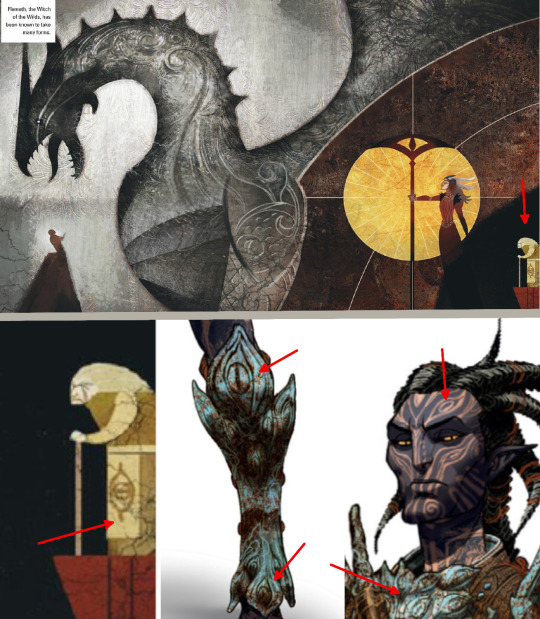
Flemeth also had a unique concept art that shows all of her nature in one drawing: her dragon shape, Mythal, as the central part of it over a human figure that may be a petitioner; a bit aside and as if she were in a inner ring of a brown sphere, The Witch of the Wild: Flemeth, with a very particular staff inside a yellow circle that may be interpreted as a Sun. And very hidden in the corner, in the core of this sphere, now black, we see her as an "old, old woman" with a big eye drawn on her apron, at the edge of a cliff [potentially representing the fragment of Mythal that lives inside her]. This kind of eye is very similar to the ones that we see in the concept art armours of Mythal’s temple guardians. I assume it has to do with her omnipresence due to the manipulation of dreams [we know that she presented herself in dreams to an elf and marked him with the Vallaslin of Mythal after awakening, check the video]
Mythal also has bland hints related to Elgar’nan symbology, which is related to the sun, fire, and balls of fire with anger [check all this in the posts Speculations about the Vinyl Art and “The Death of a Titan”]. Flemeth ends up being related to all this since she carries a fragment of Mythal in her.
[Strong] Qunari, Par Vollen, and the Solium Constellation

The Qunari have little link with the Sun, but not the land they conquered. In the book World of Thedas we are informed about the existence of the Fex, a race we never saw nor had much information beyond the fact that they exist. May they be related to the Sun or a Sun-base proto religion? We don't know.
In the Codex Constellation: Solium, we learn that this constellation [which looks like a Sun/Star, image above, pretty similar to the Chantry Sunburst I may add] may have been a representation of the Sun or the Moon [or both] for the Neomerian [Ancient Tevinters], however, it could also represent Elgar’nan, since unreliable Dalish legends claim him to be the “eldest of the Sun”.
Another Codex, called The Pyramids of Par Vollen, tells us that the Jungles of this continent have ancient ruins that doesn’t seem to be tombs but places of scientific purposes. The shape of these ruins fits perfectly with the constellation of Solium, making them, in some way or another, related to the Sun. These pyramids are a great mystery in the DA lore, especially for their total lack of information beyond this codex. We know their walls show images of “intricate sea creatures, shipwrights, musicians, archers, and kings. Odd figures are depicted, tall, horned, always in a position of authority and respect.” It seems that there was no resistance when the Qunari came to conquer this place, so we can suspect that this previous civilization embraced the Qun without much resistance, in part, because the Qunari have horns, and that caused respect and authority. Or the civilisation had been gone long ago when they came. Or it was a civilisation that was developed by or under the authority of the Kossith, the ancient Qunari who had no Qun.
The brief description of these ruins also makes me link it, potentially, with the underground ruins we find in The Horror of Hormak .
[Confusing] DAO design
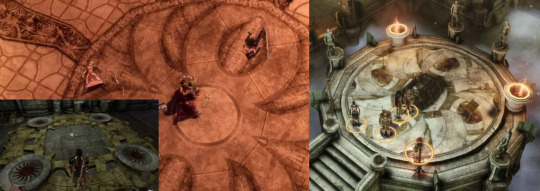
This section tries to relate the Sun shape with designs that may make the connection a bit stretched or not truly reasonable, therefore, DAO leads this part, lol.
We find that many places along the game, specially the ones related to puzzles [Honnleath and Enchanter Wilhelm’s basement] or to Tevinter experiments [Ruins of Brecilian Forest] display a platform on the ground with a symbol similar to the Sunburst of the Chantry. I’m not sure why they are there, specially in the Brecilian Forest, since we know this was a fortress probably developed by Tevinter [ which potentially may have co-opted, as usual, an ancient Elvhenan building and claimed it as its own] just to be taken by Dalish and humans later. This Fortress is a mess in terms of design and statues that it displays, so it’s hard, if not impossible, to truly take it seriously. To me it all feels more like a reuse of graphical resources, but just for the sake of completion, I add the present section.
More of these sun-like platforms can be found in the Tower of the Circle of Magi [which could potentially make sense since the tower was made by Avvar and Dwarves, and it may be a representation of the Lady of the Sky, as we saw in the Avvar section of this post] but also in the Temple of Andraste or in Denerim at the Fort Drakon which makes less sense [unless it is taken as a symbol from the Chantry itself]. Again, these inconsistencies make me suspect the reuse of assets in a game that could not afford to have 5 different platforms designs.
[Confusing] Free Marches Rural Areas
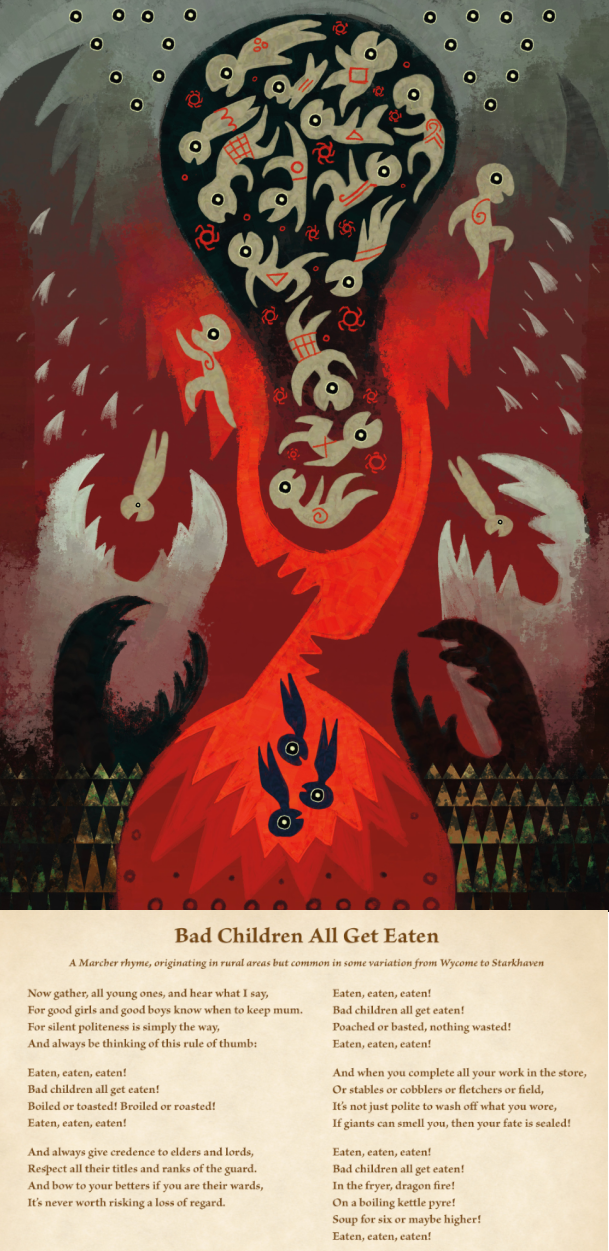
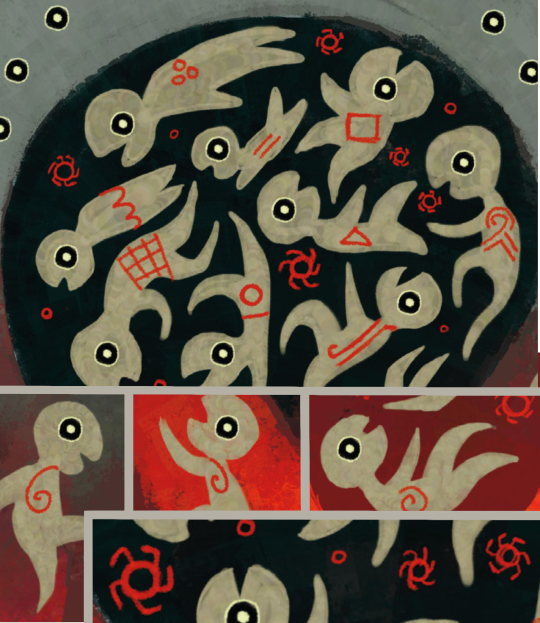
Another place where I found a sun-like symbol was in a very disturbing image of the book World of Thedas associated with a cautionary tale told to Free Marches kids. In it, we see that people/children are punished if they go outside a bubble of darkness with small “sun-like” symbols floating around. Each of these kids have a symbol on their belly or head. Curiously, one of these symbols is a small spiral that I’ve brought the attention upon long ago in the post Hinterlands: Statues, paintings, and structures found in the open where we found the alamarri statue I called Eroded dragon skull which has a “G symbol” on its back, which, at the same time, seems similar to the one present in a reiterative way all over the elvhen artefacts and in some dwarven rug designs.
I don't know how to interpret this image, mostly like the big black bubble that contains these klids seems to protect or shield them from the dangers outside. The kids that "behave badly" are dropped outside of it and are consumed by the dragon fire/jaws of the dangers outside. So in a very stretched way, we can interpret this image that the bubble filled with Suns protects people, or at least, it's the right path to follow not to be eaten by those monsters outside.
Conclusions
To put an end to this post, I would like to bring a short conclusion that we may have reached together along it. The Sun in Thedas is an ancient symbol that mostly every culture took to exploit and use in their own representation of gods/power.
This fact alone is not strange, since in anthropology we can see that severals cultures on Earth have developed religious rites or created Gods out of the Sun itself. The Sun is a symbol related to warmth, light, food, life, and security, so it seems reasonable for DA Lore to take it as the main symbol of Thedas civilisations.
The Sun in current Thedas is immediately associated with the Chantry and Andraste: it is a symbol of hope, of dawn, that provide the idea of new beginnings; it’s also the idea of the Maker itself and the Faith people have in him. It's also the fire that purifies in order to grant ascension [Andraste's case].
When it comes to Elvhenan, the Sun is immediately related to Elgar’nan, who was considered, according to the underaliable Dalish legends, the son of the Sun itself, who in order to save the Land shoved the sun into the ground, potentially causing a great damage to Dwarves and Titans.
There is also a symbol of a half-sun in an Eluvian, a statue, and in a hat worn by an elf, that may suggest that an original god, represented by the sun [potentially an ancient Dragon] was worshipped by the Evanuris. Lately, that symbol may have been co-opted by one of the Evanuris when they took divinity and the identity of the ancient gods they worshiped.
Elvhenan also seem to take the symbol of the asterisk as an oversimplification of the Sun, which across the murals, is also related to the heart of Titans, to power, and to the Golden Ring, which is also associated with control. So, for Elvhenan, we may suggest that the Sun represents immense power, if not, Divinity itself, that may end up being related to the core of Titans. The asterisk is also associated to the orb, a big power object.
Since Elvhenan were the first civilisation we know that started in Thedas [besides the Titans and their children], their symbols of power [asterisk, orb, golden ring] may have evolved along time to reach human groups which developed, later, all the sun symbols that ended up in the Chantry’s.
Thanks to Tevinter, we also can suspect that the Sun may have been a representation of an Old God, since they have a lot of sun-related images in their decoration and objects that belong to ancient times in which they were not Andrastian yet [in fact, so ancient times that Andraste herself was not born yet]. This may mean that the Sun symbol cloud have been taken from the Elvhenan or from the Ancient Dragons. Through Tevinter style, we also realise that the Elvhenan Golden Ring may have been used to create Breaches, which again shows and seems consistent with the idea of relating it to power and control. The symbol of Sun in Tevinter culture may be related originally with Elvhenan or with Ancient Dragons that Tevinter used to worship.
Dwarves have little representation of the sun for obvious reasons, but due to the unreliable legend of Elgar’nan and the war with the Titans, we may establish a relationship in which the dwarves endured the Sun [or the Elvhenan power] at some point in their story.
Thanks to the Grey Warden we can relate a sun with the idea of ancient Blood magic or ancient Dragon blood knowledge, since the Joining is represented by a chalice with a Sun on it.
The Avvar also have a low-key representation of the Sun in their Lady of the Sky, which may be just consequence of their deep relationship with the Elvhenan culture.
Par Vollen may have more answers about the Sun and ancient times, but the lore of DA world is very scarce on this region of the map of Thedas, so we can only speculate.
#Analysis and speculation of Statues#golden ring#alamarri#avvar#Chantry#Dragons#Elvhenan#Flemeth#Grey Warden#High Speculation#Old Gods#Tevinter#Par Vollen#sunburst#Sun-head creature#evanuris#Elven Ancient Shard-based door#yellow mosaic#mythal#flemeth#Elven Owl statue#Stone in Razikale-Ceremony-style#Sylaise#Elgar'nan#Asterisk Symbol#Free Marches Sun#Dwarven stone-paintings#lady of the sky
25 notes
·
View notes
Text

On the second day she drowned the giants of the sea, except those in deep waters, for they were too well-wrought, and Pride stopped her hand. (x)
@eldrtchmn crafted a gorgeous icon for me of Pride, my interpretation of a newly risen Evanuris who's taken a body and chooses a femme way to present it. She wears Mythal's vallaslin (redesign by @dreadfutures). Edlrtchmn was amazing to work with, I can't recommend her enough.
203 notes
·
View notes
Text



𝑚𝑢𝑠𝑖𝑐 𝑜𝑓 𝑡ℎ𝑒𝑑𝑎𝑠 - 𝑒𝑙𝑣ℎ𝑒𝑛𝑎𝑛🌿
"𝐵𝑒𝑓𝑜𝑟𝑒 𝑡ℎ𝑒 𝑓𝑎𝑙𝑙 𝑜𝑓 𝐴𝑟𝑙𝑎𝑡ℎ𝑎𝑛, 𝑒𝑣𝑒𝑛 𝑏𝑒𝑓𝑜𝑟𝑒 𝐴𝑟𝑙𝑎𝑡ℎ𝑎𝑛 𝑖𝑡𝑠𝑒𝑙𝑓, 𝑡ℎ𝑒 𝑐𝑖𝑣𝑖𝑙𝑖𝑧𝑎𝑡𝑖𝑜𝑛 𝑜𝑓 𝑡ℎ𝑒 𝑒𝑙𝑣𝑒𝑠 𝑠𝑡𝑟𝑒𝑡𝑐ℎ𝑒𝑑 𝑎𝑐𝑟𝑜𝑠𝑠 𝑎𝑙𝑙 𝑜𝑓 ��ℎ𝑒𝑑𝑎𝑠 𝑙𝑖𝑘𝑒 𝑎 𝑔𝑟𝑒𝑎𝑡, 𝑖𝑛𝑑𝑜𝑙𝑒𝑛𝑡 𝑐𝑎𝑡."
𝐴 𝑔𝑟𝑒𝑎𝑡 𝑚𝑎𝑛𝑦 𝑟𝑢𝑖𝑛𝑠 𝑐𝑎𝑛 𝑏𝑒 𝑓𝑜𝑢𝑛𝑑 𝑖𝑛 𝑇ℎ𝑒𝑑𝑎𝑠 𝑡ℎ𝑎𝑡 𝑠ℎ𝑜𝑤 𝑡ℎ𝑒 𝑔𝑟𝑒𝑎𝑡𝑛𝑒𝑠𝑠 𝑡ℎ𝑎𝑡 𝐸𝑙𝑣𝑒𝑠 𝑜𝑛𝑐𝑒 𝑤𝑒𝑟𝑒. 𝑌𝑜𝑢 𝑠𝑖𝑡 𝑜𝑛 𝑎 𝑐𝑜𝑙𝑙𝑎𝑝𝑠𝑒𝑑 𝑐𝑜𝑙𝑢𝑚𝑛, 𝑜𝑣𝑒𝑟𝑟𝑢𝑛 𝑏𝑦 𝑡ℎ𝑒 𝑓𝑜𝑟𝑒𝑠𝑡, 𝑎𝑛𝑑 𝑡𝑟𝑦 𝑡𝑜 𝑖𝑚𝑎𝑔𝑖𝑛𝑒 𝑤ℎ𝑎𝑡 𝑡ℎ𝑒 𝑝𝑙𝑎𝑐𝑒 𝑤𝑎𝑠 𝑙𝑖𝑘𝑒 𝑏𝑎𝑐𝑘 𝑡ℎ𝑒𝑛. 𝑆𝑢𝑟𝑒𝑙𝑦 𝑡ℎ𝑒𝑦 𝑑𝑎𝑛𝑐𝑒𝑑. 𝑌𝑜𝑢 𝑘𝑛𝑜𝑤 𝑓𝑜𝑟 𝑎 𝑓𝑎𝑐𝑡 𝑡ℎ𝑒𝑦 𝑓𝑟𝑜𝑙𝑖𝑐𝑘𝑒𝑑 𝑡ℎ𝑟𝑜𝑢𝑔ℎ 𝑡ℎ𝑒 𝑓𝑜𝑟𝑒𝑠𝑡. 𝑊ℎ𝑒𝑛 𝑦𝑜𝑢 𝑓𝑖𝑛𝑎𝑙𝑙𝑦 𝑐𝑎𝑡𝑐ℎ 𝑦𝑜𝑢𝑟 𝑏𝑟𝑒𝑎𝑡ℎ, 𝑦𝑜𝑢 𝑑𝑒𝑐𝑖𝑑𝑒 𝑡𝑜 𝑑𝑜 𝑠𝑜𝑚𝑒 𝑓𝑟𝑜𝑙𝑖𝑐𝑘𝑖𝑛𝑔 𝑦𝑜𝑢𝑟𝑠𝑒𝑙𝑓.
8𝑡𝑟𝑎𝑐𝑘𝑠 / 𝑦𝑜𝑢𝑡𝑢𝑏𝑒
#music of thedas#dragon age#dragon age inquisition#fanmix#my fanmixes#playlist#elvhenan#dragon age dreadwolf
13 notes
·
View notes
Text
The Truth
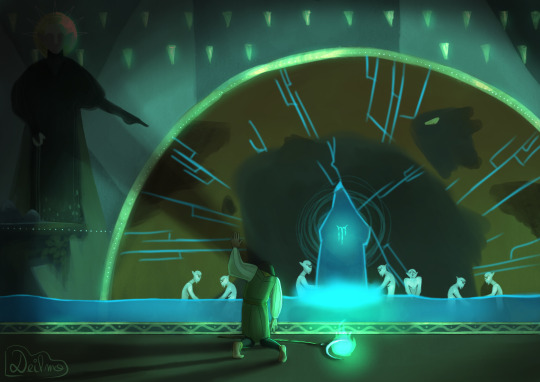
"Hail Elgar'nan, All-Father, who struck down the pillars of earth and let us collect their gift. Let the lyrium flow through our hands until it reaches our gods, craft them the jewels worth their kindness and praise their name forever!"
In the time of Arlathan, the Evanuris struck down the pillars of earth, Mythal was one of them. Deep in her mines, dwarves worked tirelessly to extract and shape lyrium to her fancy. First afraid, they had kept hidden, but soon warmed to her. In the absence of their titan, she would look over them in this world that now seemed foreign.
Other Evanuris didn't get that chance. The dwarves hid, attacked or fled, never to return. To work their mines, they had to rely on their own kin, knowing the dangers of handling such raw substances.
Promise of freedom, of warm food and a shelter is what convinced so many of those elves to walk down the mines, never to return. Those elves soon got replaced with opponents, rebels, war veterans that remembered the Evanuris before. Anyone that would oppose the Gods and their divinity.
Solas should've been one of those elves. He was cocky, saw the war, ran his mouth no matter his audience, a free spirit, no matter how many years he had spent in servitude. So, why?
-*-
One of the two drawing I made from screenshots of The Prince of Egypt. Started this when I remembered the comment that the titans were Solas' catalysis for his rebellion, realised it is mentionned Mythal kept dwarves in her mines, but there was no mentions of how the other Evanuris mined it... Came up with this.
This was half inspired by Prince of Egypt, half inspired by Hadestown. More specifically: Way Down Hadestown, Epic 2, and Way Down Hadestown II.
#dragon age solas#dragon age#solas fan art#fen harel#dread wolf#elgar'nan#evanuris#elvhenan#yes i'm back on my hadestown inspiration#you can rip hadestown from my cold dead hands thanks#Orpheus as Solas just fits okay?#of course Elgar'nan is Hades#and the fates can be the people#also begging for Mythal as Persephone#my art#I've got a whole story about Solas inspire by Hadestown's music don't try me
37 notes
·
View notes
Text
Fen’Harel and Elgar’nan (in that respective order) - Ruthlessness: Epic
This only took me like 30 minutes, but this song gave me a brain worm so I rushed to make it fr

Elgar’nan concept art
I’ve been neglecting my tumblr, my bad ya’ll
#dragon age#dragon age inquisition#art#dai#dragon age dreadwolf#dreadwolf#Elgar’nan#Fen’Harel#solas#Elvhenan#Arlathan#ancient elves
16 notes
·
View notes
Text

Day 17. Evanuris
#dragon age#dainquisition#dragon age fanart#lavellan#ancient elven inquisitor#inquisitor lavellan#dai#dragonage#da ocs#Thia Da'halla Lavellan#evanuris#elvhenan#inktober#inktober2023
126 notes
·
View notes
Text
Red Lyrium

#red lyrium#corruption#solas x lavellan#dragon age inquistor#lavellan#solasmance#solavellan#dragon age inquisition#dread wolf rises#dread wolf#dreadlove#fanfic#lovers#dalish#da solas#solas dai#evanuris#elvhenan
64 notes
·
View notes
Link

This post is for all of you who may want to check out this Dragon Age fic I wrote. It’s set in Elvhenan, has Solas aka Fen’Harel as the protagonist, explores the DA lore (like, a lot), and is about 200,000 words long. Also, it’s complete! 🥳
All details below the cut. Happy reading!
Chapters: 34/34
Fandom: Dragon Age (Video Games), Dragon Age: Inquisition
Rating: Explicit
Warnings: Graphic Depictions Of Violence
Relationships: Fen'Harel | Solas/Original Female Character(s), Solas (Dragon Age)/Original Female Character(s), Fen'Harel (Dragon Age)/Original Elvhen Character(s), Elvhen God(s) & Solas (Dragon Age)
Characters: Fen'Harel | Solas, Solas (Dragon Age), Mythal (Dragon Age), Elgar'nan (Dragon Age), Dirthamen (Dragon Age), Andruil (Dragon Age), Sylaise (Dragon Age), Ghilan'nain (Dragon Age), June (Dragon Age), Falon'Din (Dragon Age), the Evanuris, Elvhen God(s) (Dragon Age), Original Characters, Ancient Elf | Elves (Dragon Age), Geldauran (Dragon Age), Anaris (Dragon Age), Dearn'thal (Dragon Age), The Forgotten Ones (Dragon Age), Abelas (Dragon Age)
Additional Tags: Dragon Age Lore, Elvhen Pantheon, Elvhenan, Elvhen Lore, Elvhenan Culture and Customs, Arlathan (Dragon Age), Pre-Canon, Speculations on Elven History, Speculations On Pre-Veil Magic, The Blight (Dragon Age), Titans (Dragon Age), Possibly Unrequited Love, Sexual Tension, Eventual Romance, Eventual Smut, Friends to Lovers, Friends With Benefits, Smut, Romance, Complicated Relationships, Friendship, Friends to Enemies, Angst, Hurt/Comfort, Grimdark, Canon-Typical Violence, Violence, Threats of Violence, Blood, Injury, Blood and Injury, Torture, Past Torture, Past Abuse, Implied/Referenced Torture, Explicit Sexual Content, Drug Use, Recreational Drug Use, Sex Work, Solas (Dragon Age) is Grim and Fatalistic, Mutual Pining
Series: Part 1 of The Rise & Fall of Fen'Harel
Summary:
He didn't want a body but she asked him to come.
He left a scar when he burned her off his face...
In the days of ancient Arlathan: Solas wanders the world as Mythal's loyal servant when the Evanuris give him an impossible task. It doesn't take long for Solas to find out that each of the gods has plans of their own. While Andruil has returned from the wilds wielding a darker kind of magic, Dirthamen and June try to trace the origin of her new power. Solas can either submit to the rule of the gods or walk the path of rebellion to save the ones he loves.
Here's a story about how young Solas became Fen'Harel that nobody asked for but I wanted to write anyway. Happy reading!
NSFW chapters will be marked with *
#dragon age#fanfiction#dragon age fanfiction#dragon age inquisition#solas#fen'harel#solas x oc#solas x female oc#solas x elvhen oc#elvhenan
54 notes
·
View notes
Text
What I Think Dragon Age Dreadwolf will do with the Evanuris: The Evanuris are just like Solas in that they are people. Some of them can be reasoned with, and maybe even convinced to join your side against Elgar’nan, Mythal, and Fen’Harel.
What I Hope Dragon Age Dreadwolf will do with the Evanuris: The Evanuris may not be gods, but they are also not quite what Solas described them as. He is incredibly biased on this particular subject just as mythological Loki would be when asked about the gods of Asgard. The game treats them as it does with the maker in a “Maybe, Maybe Not” Situation. The Dalish are validated and vindicated in their beliefs as the Evanuris, once freed, try and right the wrongs done against the people with you trying to convince them not to kill off all of humanity for everything it has done to the elves.
What I Fear Dragon Age Dreadwolf will do with the Evanuris: The Evanuris are not only all irredeamably evil, but also are completly responsible for the Blight, for Darkspawn, for Everything that has ever gone wrong with the world and werew in fact responsible for the Magisters entering the Fade instead of the old gods. The game ends with all the elves of Thedas, especially the Dalish, being told that they must give up all the traces of the Elvhenan and go convert to andrastianism since their gods are actually evil and bad unlike the Maker. The game puts this forth as a good thing.
#dragon age#dragon age dreadwolf#da4#da4 speculation#evanuris#fen'harel#elgar'nan#mythal#elf rights#dalish#elvhenan
42 notes
·
View notes
Text
I wonder if Solas has ever let himself mourn his people, his culture, his memories, if he ever let his walls down, crying & screaming & letting all the grief & anger out. He wants to bring it all back, so has he ever accepted his loss? No. I hope he will heal in DA:D.
#Dragon age#Dragon age inquisition#Solas#solas dragon age#dread wolf#fenharel#Dragon age Dreadwolf#BioWare#Arlathan#Elvhenan#I hope we will get a happy ending with him we deserve it#This post is also on my Twitter ✌🏼
15 notes
·
View notes
Text
Solas sharing Lore - Part 1
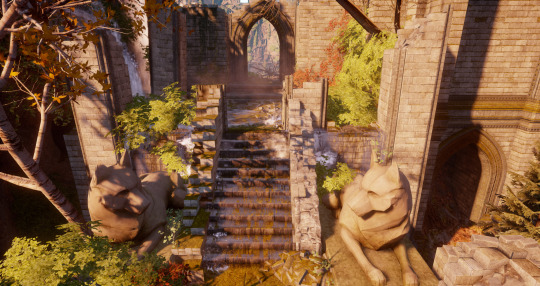
This post is focused on what Solas says about the lore of the world of DA series. It's not about Solas as a character [although I would try to explore his nature as a way to understand the nature of the Elvhen and the spirits]. Since Solas is one of the living elvhen who knows the truth of what happened with the Evanuris and the Tevinter expansion after the fall of Arlathan, I consider his words one of the most valuable ones in the series. He does not lie, but omits what he doesn't want to speak about or adds technicalities that make his statements true yet misleading if we don’t pay attention to the context. Unlike Flemeth, he speaks with less riddles, so I considered worth listing all the knowledge he shared with the Inquisitor in order to have a reliable information of how “the world” of Thedas truly works.
The list of topics related to the lore shared by Solas is
Dreamers and their powers
The Elvhenan and the Dalish
The Demon/Spirit Nature
Solas’ Personal quest [deeply related to Spirit’s nature and his own]
Solas’ nature
The Fade and the Veil
Magic
The Orb
The Evanuris and worshipping
Organisations/Institutions/Empires
The Blight and the Grey Wardens
Maker
Miscellaneous Knowledge
Trespasser Revelations
Solas sharing Lore: Part 1 - Part 2
Dreamers and their powers

Sommniari or Dreamers can sleep close to a ruin which has endured time, or battlefields that had been steeped in death, they attract spirits and it will help a dreamer to see the past of that place.
Solas claims to be able to walk “deep into the Fade” [which reminds me the codex The Deepest Fade and Walking the Fade: Frozen Moments]. The deepest Fade is, potentially, the place where the Forbidden Ones were exiled. It’s not clear how much literally he means “deep into the Fade”.
It's important to set wards when entering the Fade through dreams [we saw this with Felassan in The Masked Empire]
Solas claims that seeing those pieces of the past make him thrill, even though I suspect it is for different reasons than mere enthusiasm, they were part of his living past, one he yearns deeply.

I’m not so sure if I should catalogue this information as part of the dreamer’s power, but we know by all what Marethari said in Feynriel - Somniari and Fade, a dreamer can use the power of the Fade in a similar way as it’s described by rift mages.
We learnt in Solas’ personal quest that tea and blood magic interfere with the Dreamer’s ability of entering and walking in the Fade.
The Elvhen and the Dalish
During the first minutes of the game, Solas will share with us that he was attacked by Dalish when he tried to question the Keeper's knowledge of their gods and customs. This means that he tried to approach the People, these mortal elves that are so different to the Elvhenan, and tried to share his knowledge of the past, being rejected by them, and suffering what the game has subtly called the Dalish Pride. It’s quite an irony that the group that wants to treasure the old ways rejects the one who lived them in his bones.
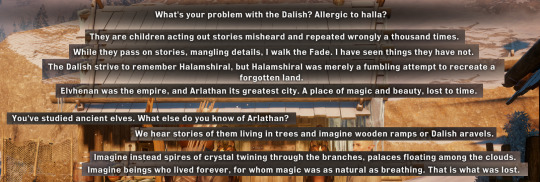
Solas insists that Dalish Tales are misheard stories that were repeated wrongly thousand of times. This line is the main reason why I do not trust Dalish Tales for any kind of analysis. Solas assures us many times that, despite having some distant resemblance or detail to something that has happened in the past, they are mostly wrong.
He emphasise that the Dalish try to remember Halamshiral, not the Elvhenan time. Halamshiral was a time where the Dalish tried to recreate the Elvhenan empire, but they ended up accommodating and changing a lot of their own tales due to the influence of the Andrastian faith [as we see in Emerald Graves: Din'an Hanin].
The original [true] elven Empire was called Elvhenan, and Arlathan was its greatest city. He does not say what potential main god may have been central in it [we learnt that elvhenan cities seem to have a Temple in honour of one of the Evanuris around which the city develops, The Temple of Mythal].
Arlathan was made of spires of crystal twining through the branches of trees and of palaces floating in the skies. Elves [he makes the subtle detail of calling them beings, maybe because these elves were more elven-spirit] were immortal and magic was natural in this world. It may imply that, since magic was natural, all elvhenan had some degree of magical power.

Solas: The Dalish remember fragments of fragments, but that is more than most.
Solas: It is a shame, Sera, that you were denied an elven life. Even one as patchwork as the Dalish interpretation.
The Dalish lifestyle, separated in clans, developed a cultural diversification of the Dalish. Some clans are more bandit-oriented, others are more mercantile, and others disappeared into the forest [this is probably an allusion to the Dalish living in Tirashan; which seem to be quite a curious clan according the tabletop corebook of DA]. This implies that the Dalish, the “holders of the ancient true knowledge”, have followed a path that inevitably causes diversification and inaccuracy in the lore they want to keep, and this is even worse if we think they lore is usually kept orally, a form of transmission of knowledge very fragile to loss and modifications over time.
He is convinced that Dalish only hold fragments of an already fragmented History. We later discover in the game that the Dalish have been embracing a lot of slavery icons thinking it was part of their cultural history, which ironically, it is. The “old ways” was a lot about slavery and power of the Evanuris and noble over the less powerful elvhen: The People.
If we have low approval and kill Abelas’ people, Solas angrily says that the Inquisitor has destroyed the few “true elves” that were left. So, Solas is totally convinced that City elves and Dalish are not true elves. We see this same attitude with Abelas when he meets the elven Inquisitor, and it’s also believed by Felassan in the The Masked Empire. The only ancient “elvhen” who sees the Dalish as The People is Flemeth/Mythal, who has been “changed”, according her own words, due to her death and the suffering of betrayal [check “The Fade - Flemeth: Part 2″].
With low approval, he claims that the only way he can save the “elves” is to bring down the Veil, bring the Fade into the Waking World, and reshape reality, which is, ironically, exactly what he plans to do.
In Din'an Hanin, when we interact with a statue of an Emerald Knights, Solas says
Solas: The Emerald Knights. They once patrolled the borders of the Dales, protecting the Elven people. The Dalish saw them as romantic heroes. The Chantry called them ruthless butchers. I suspect both sides have some element of truth.
This reinforces the idea that he knows that situations are greyer than what the groups tend to believe.Especially when it comes to Dalish.
The Demon/Spirit nature

Solas is against the oversimplified explanations of spirits and demons made by the Chantry. The distinction he does between both is that demons are spirits that wish to join the living but the wish "went wrong".
In a world separated by the Veil, it's not possible coexistence between living creatures and spirits. But in a world without Veil, this is possible. [In fact, we saw this coexistence in Vir Dirthara: Attentive Listeners]. My personal speculation about why he says this is probably because most spirits that cross the Veil get extremely confused with the unchangeable nature of the Waking World and some twist into demons as this world makes no sense for them and they try to adapt to it but fail, making impossible to execute their purpose. We see that only through shape they can adapt a bit: Justice took Kristoff’s body in the beginning, and Cole created his own body reflecting the original Cole.
The presence of the Veil makes difficult true understanding between living creatures and spirits.

Solas has travelled and made lasting friendships with spirits of wisdom [who shared knowledge with him], and spirits of Purpose [helped him search].
These benevolent spirits don't seek the living world because they can't survive the exposure to the people. Wisdom and Purpose are easily twisted into Pride and Desire.
Solas explains that the reflective nature of the Fade makes the spirits try to reflect what the living creatures think they are. So spirits reflect all the time the intention that others want from them. In Solas’ personal quest we saw this clearly: If a person wants a fighter from a spirit of wisdom, the spirit reflects this expectation and ends up turning into a “demon” because it goes against its purpose of learning and teaching. Instead, if the person reinforces the wisdom, expecting from that spirit to teach them, the spirit becomes stronger in its own purpose and can exist more comfortable in this world. This is also confirmed by the Avvar, whose whole lifestyle is supported by their interaction with good spirits.
This lore makes the Chantry as the main cause of corruption of spirits through their teachings: they tend to teach that anything non-living is a demon, and a gentle spirit may end-up feeling the compulsion of becoming a demon just because the living are expecting that from it. We can see how terribly wrong the Chantry is, and what a deep understanding of the spiritual world the “savage” Avvar have in contrast.
If one understands the nature of the spirit and reinforces their nature, the spirit remains as a friend.
Solas brings here an interesting philosophical discussion about the nature of a “person”, making us remember another we had with Owain, the Tranquil mage of the Circle of Magi in DAO. The reasoning is the following: spirits are bound to their nature and purpose and not their shape, as it happens with people, hence they are people too. It’s explicitly said that the nature of the spirits may change depending on its contact with people [this contact is what can make them demons or stronger in their own purpose]. This concept brings us a lot of potential explanations about Mythal’s cryptic lines about she being changed and different to the embodiment of motherhood she used to be when you, as an elf, asks Flemeth why Myhtal was silent to the prayers of the People [The Fade - Flemeth: Part 2] . I think it’s clear that Mythal’s has twisted her role and nature after her death. In fact, she may have changed it even previous to that event, when she started to impart justice in the name of Elgar’nan [The Judgment of Mythal, then she ended up being a goddess of Revenge before her death: Arbor Wilds: Altar of Mythal,].
Solas says that anyone who can dream can make friends with these spirits if their natures are respected [this would explain why the Avvar mages seem to do so well with their willingly possessions, I really can’t stress enough how amazing and admirable are the Avvar in the way they see the world and treat their mages. Like… if the Chantry says that free mages always end up as Tevinter, they truly never saw the Avvar. They are probably the only humans who “got it right”.]
Solas defends the idea that spirits are people, despite not having a form as "we understand it". This brings to our mind several Ancient Elven codices from Vir Dirthara, where shape doesn't exist truly. One in particular is Vir Dirthara: Birds of Fancy where two spirits make love in the most amorphous way ever. So, it’s clear that in Elvhenan society, shape did not exist, and the personhood was given by the interactions with others and the personal purposes that each of them had. As an inference, we can assume that the basic sexuality in the Elvhenan society, if it existed, was pansexual since shape is always an ambiguous amorphous thing.
In Banter we have a reinforcement of all this information:
Cole: I didn't know there were spirits of wisdom.
Solas: There are few. Spirits form as a reflection of this world and its passions. We will never lack for spirits of rage, or hunger, or desire. The world gives them plenty to mirror. The gentler spirits are far more rare. We can ill afford the loss of even one spirit of wisdom, or faith...Or compassion.
Cole: I will try not to die.
Solas: Do that, please.
Solas says that there are few spirits of wisdom because Thedas has little desire to learn and teach, instead, there are many spirits of rage, hunger, and desire, because that’s all what Thedas is filled with. The gentle spirits are rarer, specially, compassion, faith, and wisdom.
Solas: How go your attempts to ease the pain of those at Skyhold, Cole?
Cole: I made the scullery maid stop crying and one of the boys in the stable is happier. Some of the servants are angry. My help makes work for them. Do you want me to stop?
Solas: No. You exist to help others. You are kindness, compassion, caring. If you stop giving comfort, you would twist into something else, as you did before I suspect.
Cole: Yes. I will not be that again.
Solas: Good. Never forget your purpose. It is a noble one, even if this world does not understand
Here, we have a reinforcement of the vital importance of letting the spirits keep on their purpose, otherwise they twist into something else. Cole, however, is special. We know we can humanise him and in any case, he will evolve into something different but not demonic. I’m going to talk more about his case when talking about “Solas’ Nature”.
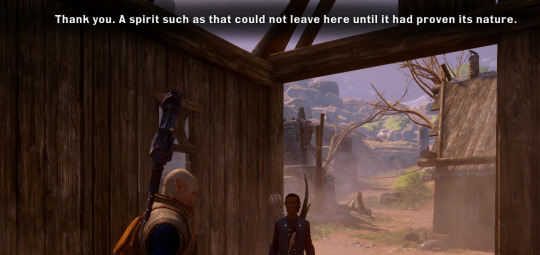
This concept is reinforced again in Crestwood when we meet the spirit of Command.
Cassandra: Solas, I am sorry about your... friend.
Solas: Thank you.
Cassandra: I knew demons and spirits were similar, but I did not know one could become the other so easily. Not similar, Seeker. The same. The Chantry sees black and white, but nature is, and always has been, grey. A spirit is a purpose. A demon is that purpose perverted.
Cassandra: That might be true with a spirit of compassion, but what is the purpose of a hunger demon?
Solas: Survival. Satiation. The pleasure of taste, of feeding. True hunger, however, is much darker. Think of all those who starve in this world. Mankind has itself to blame for the existence of demons.
We learn in this banter many things:
Seekers, and by extension Templars, had no idea that demons and spirits are the same but just a twist or corruption is what makes the difference.
Solas reinforces, once again, the idea that spirits and demons are the same.
Nature is grey, never black and white, no matter how much the Chantry wants it to be.
What Thedas produces is what the spirits reflect, and since Thedas is currently dominated by humans and their perception of the world, Mankind has a lot of blame in the existence of demons.
Cassandra: I had not considered how fighting in our world might affect the Fade. Is it always thus, Solas?
Solas: It is worse this time, with the Breach pulling spirits through against their will... But, yes. Every war, no matter how just, leads to hunger and rage... and so come the demons.
Cassandra: It is said that generals should avoid fighting in the same battlefield too many times...
Solas: The deaths, the rage - all of it weakens the Veil. But nothing is ever said of the effect war has upon the world of spirits, what we might be doing to them. Every war has unintended victims. All too many go unnoticed.
Solas keeps reinforcing the idea that what happens in Thedas is reflected later in the Fade and in the spirits.
Dorian: Do you use spirits as servants, Solas? You'd have no trouble capturing them.
Solas: No. They are intelligent, living creatures. Binding them against their will is reprehensible.
Here we can see how Solas sees spirits as people, and this comment is probably the reason why some frictions between Solas and Dorian can be seen later.
Blackwall: Do you have any advice for fighting demons, Solas?
Solas: Survive the first thirty heartbeats, and you'll have already won.
Blackwall: So I should try not to die? Helpful.
Solas: I mean that demons are rarely intelligent enough to change their tactics. If you focus on defending yourself, you will see the full range of their abilities within the first thirty heartbeats. By then, you should be able to find a weakness and exploit it.
Blackwall: Ahh, that is helpful! I will try to remember that.
Solas: Also, try not to die.
Solas seems to claim that demons rarely change their tactics. Probably this is based on the most emotional demons, such as Rage or Hunger. I have my doubts when it comes to the Pride demons, who are considered the most powerful ones among the demons and the most cunning too [not by chance the book Tevinter Nights .
Cole: Is there a way to save more spirits, Solas?
Solas: Not until the Veil is healed. The rifts draw spirits through, and the shock makes demons of them.
Cole: Pushing through makes you be yourself. You can hold onto the you. Being pulled through means you don't have enough you. You become what batters you, bruises your being.
Solas: Yes, exactly. Deliberately crossing the Veil requires that a spirit form will, personality. That concept of self gives a spirit the chance to maintain its nature. Wrenched into this world unwillingly by the rifts, spirits suffer the same fate as my friend.
Cole: Then we will help them.
This is something quite interesting lore-wise. It says that the only spirits that can pass through the Veil without being turned into demons through the shock are those who had developed personalities: the spirit has become complex, it can fulfil its purpose from different perspective and aspects, therefore it becomes stronger in their own purpose. I suspect the elvhen were in this level. So far we know, Mythal embodied things such as Wisdom, Motherhood, Justice and Revenge. Solas is a combination of Pride, Wisdom, and Rebellion. Abelas was also a combination of things we don’t know because we don’t know his previous names, but apparently, he changed his name every time his purpose changed. Cole is a rare exception as usual. Another spirit I can think of is Justice. He was certainly pulled into the Waking World, but it seems he had enough personality to survive as Justice, but the exposure to other people started to make him feel other things [remember he realised about Jealousy and Love with Kirstoff’s wife]. His change of purpose into Vengeance was more caused by the direct feeling of Anders’ rage inside, sadly.
Cole: If it helps enough people, it becomes more... wandering, wishing, touched by them, Maker loves you, and it grows. But I am me. Will I be more one day, if I help enough? Is this a task, timed, temporary?
Solas: No. It is a mistake to ascribe human motivations to them.
Cole: So I am always this?
Solas: You are always you.
Here, Cole repeats the idea that reinforcing the purpose of the spirit makes the spirit be more themselves.
if Cole becomes more human:
Solas: How do you feel, Cole, now that you dealt with the Templar?
Cole: I don't know. He hurt me... hurt the real Cole. I'm angry at him. I can't let that go. I have to become more, let it make me real.
Solas: You may well become fully human, after all. I never thought to see it.
Cole: When did you see it before?
Solas: I did not say that I had.
Cole: No, you didn't. It's harder to hear, sometimes. Sorry.
Solas: Good luck, Cole. You have taken a difficult road.
Here, we can see that Solas saw this process once. Let’s remember that Cole, as he becomes more human, can hear less the depth of the creatures around him, so I’m pretty confident this banter means that Solas thought something along the lines “ I never thought to see it again”, but only said the first part. If we also remember that spirit-Cole says: "He did not want a body. But she asked him to come. He left a scar when he burned her off his face." we can suspect that Solas was implying that the other creatures who became mortal were the elves, or himself.
Solas personal quest

He teaches us that some spirits want to come to the Waking World, but not all.
By the description of it, this spirit friend of Solas sounds similar to the one giving the lecture in Vir Dirthara: Attentive Listeners.
The perversion of a spirit of wisdom can be done too by forcing them to speak or release a piece of information they don’t want to.
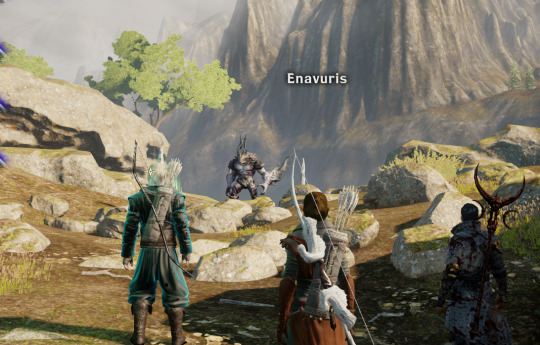
I’m not sure how important or meaningful is the fact that this quest happens in a place called Enavuris. Sadly, we don’t have any means to understand this word.

Demons are spirits whose purpose has been perverted or forced to be another. What corrupted Solas’ friend was to be summoned and commanded to do something different to its nature.

I think here we can see some details about the bound process and how a demon is created: summoning a spirit, bound it to obedience, and force it to do something different than its purpose. Forced change is different to a spirit changing itself due to the people they interact with. Clearly here the key is the willingness, as it seems to be key in all spirit-related matters [we need to always remember Flemeth’s words about “A soul is not forced upon the unwilling”].
The inquisitor can propose to remove the binding circle, so free of orders, the spirit should return to its previous form.

Once the spirit is free, we see that it speaks Elvish, and you only understand this if the inquisitor is an elf.
We don’t see its ears, but its physique looks like a human. I suppose this shape is consequence of the mages that summoned it, so it reflected a human shape. Its eyes are full of Fade.
Solas asks for forgiveness for having failed her. The spirit is grateful anyway because it recovered its nature. I find it curious how it asks him to guide it into death. I also wonder why it dies, as a spirit who recovered its nature and was not harmed in the process of releasing it… why does it die? I wonder if this is just a small incoherence to continue Solas’ story.
Solas will endure as yet another spirit of wisdom dies.
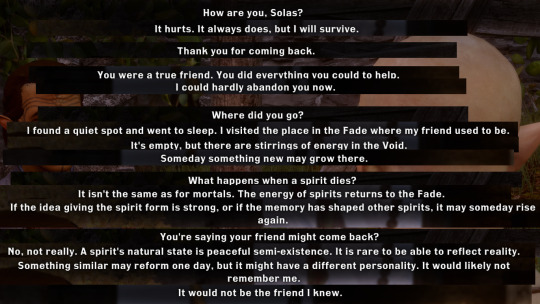
When Solas is back to Skyhold, he says he went to the Fade to see the place his friend inhabited. He claims it’s empty now, but “there are stirrings of energy in the Void”. I’m confused with the capital letter in Void. We know that Void and Abyss are exchangeable in DA lore, and they are deeply related, ironically, to the depths of the underground [The Uncharted Abyss, Forgotten Caverns, Bastion of the Pure, and The Wellspring], and the more lore we learn, the more we relate it to the Titans and the Deep Roads.
He says that something new will grow in that spot. So… is this a subtle detail about the nature of death of spirits? Does a death of a spirit cause a stir in the Void that will produce something new there, inspired by what was lost? Can anything of this be related to the “dreams of the Titans”? No real clues to follow.
Once more, I’m a non-native English speaker, and I can’t stop noticing how the verb “stir” is used in DA: it has been used explicitly with Titans, and then left vague in less explicit cases like this. “The Stir of the Void energies”, which seem to be related to the underground, could also mean that this comes from some residual power of a Titan? Did the Titans create the Spirits and the Fade in the skies as well as the dwarves in the underground? There is so little information to explore this question that I doubted to even write it here. We know that the future of DA may be related to Titans, as Exaltations from the Chant of Light - Part 2 as well as the Mural of “The Destruction of the Veil“ seem to imply. We should never forget this is a game where, obviously, dev choices lead the story, and the fact that Exaltations is a text which talks about the return of the Maker implicating creatures such as Titans and beast-humans should not be overlooked. This is, after all, a lore element used by the devs as an in-world prophecy.
Anyways, Solas explains that death is different for mortals than for spirits [implicitly he may be saying that death is also different for immortal Elvhen and for mortal elves]. The spirits return to the Fade; if the idea giving shape the spirit is strong [meaning, there is enough idea in the Waking World for it to have a strong impact in the Fade], or its memory has shaped other spirits [meaning, other spirits will remember the dead one and such memory, if strong, can reconstruct it in the new reborn spirit], it may raise again as a consequence of reflecting what others reflects from its previous life [ this is exactly what he explained to us in the beginning of the game, in Haven, when talking about the nature of the spirits and their personhood]. However, due to the semi-existence nature of the spirits, the return produces a reset in their memory and personality. This doesn’t seem to be the case for Flemeth or Corypheus, but they are more complex than mere spirits.
Solas’ nature
Cole: You're different, Solas. Sharper. You're in both places.
Solas: I visit the Fade regularly. Perhaps you are sensing traces of it. You are a spirit who crossed the Veil and took human form.
Cole: Spirit or demon.
Solas: The two are not so dissimilar, Cole. While the world may exert a pull in one direction or another, the choice is ultimately yours.
Cole says that Solas is in both places. This plays beautifully vague: Creators and Forgotten Ones, Fade and Waking World. This may suggest that Solas’s shape as an elf and as a wolf may have been dissociated [ “Self-portrait”] and his Wolf shape is the one roaming the Fade or the inside the Black City, vigilant as we conclude in several murals [ “The actions of the Inquisitor”, “The Creation of the Veil”]
if Cole becomes more human:
Solas: How do you feel, Cole, now that you dealt with the Templar?
Cole: I don't know. He hurt me... hurt the real Cole. I'm angry at him. I can't let that go. I have to become more, let it make me real.
Solas: You may well become fully human, after all. I never thought to see it.
Cole: When did you see it before?
Solas: I did not say that I had.
Cole: No, you didn't. It's harder to hear, sometimes. Sorry.
Solas: Good luck, Cole. You have taken a difficult road.
Here, we can assume that Solas saw the process of a spirit becoming mortal once, and considering the line of Cole: “He did not want a body. But she asked him to come. He left a scar when he burned her off his face" we can suspect that the other creatures who became mortal were elvhen, or Solas himself. So there is a set of subtle details that may suggest that the process that Cole passed through to become a spirit with shape or even a human was similar to the one that Solas himself passed through long, long time ago.
Blackwall: I am sorry about your... friend. Losing someone is difficult.
Solas: Thank you. The death itself was less painful than what came before. Seeing a good spirit twisted, its nature defiled. Those mages knew nothing of my friend. Worse, they did not care.
Blackwall: I... don't know what to say.
Solas: Nor will you, until you've seen ignorance snatch away all that you love. Pray such a day never finds you.
Another reinforcement of how spirits are twisted when forced against their purpose, which is a constant thing in Thedas, filled with so much ignorance about spirits due to, mainly, the Chantry’s teaching.
Blackwall: You make friends with spirits in the Fade. So... um, are there any that are more than just friends? If you know what I mean.
Solas: Oh, for... really?!
Blackwall: Look, it's a natural thing to be curious about!
Solas: For a twelve-year-old!
Blackwall: It's a simple yes or no question!
Solas: Nothing about the Fade or spirits is simple, especially not that.
This is a very interesting concept that we saw and read in the codex Vir Dirthara: Birds of Fancy where, effectively, we can see the complexity in the lack of shape that creatures in the Fade had. Of course Blackwall makes it more like a joke, but we know that there is more to it.
Blackwall: For all your experience, Solas, you don't carry yourself like a soldier.
Solas: You should have seen me when I was younger. Hot-blooded and cocky, always ready to fight.
Blackwall: Ah, youth.
Solas: It is a delicate balance for those who fight. If they lack sufficient passion, they never become truly skilled, and die or leave the life.
Blackwall: But too much passion, and they end up dead; or monsters better off dead.
Solas: Yes. It is a rare soldier who can fight without letting it define him.
Here, Solas speaks of soldiers and fighting as things that produce a change in the purpose of a spirit or an elvhen. He may imply that his fight may have changed him at some point, and hence my suspicion that he was more like a spirit of Wisdom or Pride, who due to Mythal’s request, he changed purpose and embraced shape, as it may suggest Cole’s cryptic line: “He did not want a body. But she asked him to come. He left a scar when he burned her off his face.”
Iron Bull: Nice job in that last fight, Solas. You really kicked the crap outta that guy.
Solas: I suppose.
Iron Bull: What, you don't think so? You ripped him a new one. It was great!
Solas: Unless the fight is personal, violence is a means to an end. It isn't appropriate to celebrate.
Iron Bull: I don't know. Gotta wonder about anyone who fights as much as we do and doesn't have some fun with it.
Solas: We have fought living men, with loves and families, and all that they might have been is gone.
Solas: You fought the Tal-Vashoth for a long time, Iron Bull, did you not?
Iron Bull: Every day. I'd kill some of them, they'd kill some of my guys, and then I'd kill them some more.
Solas: No man can kill so many people without breaking inside. To survive... those you fight must become monsters.
Iron Bull: The ones that kill innocent people, yeah. The rest... I don't know.
Solas: The mind does marvelous things to protect itself.
This is something very impressive that Solas says, since it’s part of the process that many soldiers make up in their minds so they can kill innocents, specially in countries they invade, and keep it like “it is duty and shit”. Solas is basically comparing this mechanism with the one that the Qun uses in their soldiers. This speaks not only of the brainwash that the Qun causes and that Solas despises deeply, but also may be subtly speaking about Solas: he never stops repeating the Inquisitor that all those people they kill had families and loved ones, he is always making them “humans”, reminding their individuality and personhood, even if it fills the killer with a lot of guilt. These lines probably make sense only after a time of Solas living in the Inquisition to make him recognise the personhood of the current mortals of this separate world [we need to remember that in the Tresspasser DLC he confessed that he did not see mortals as people when he woke up from his slumber, it took him a while to recognise it]. So, this constant “humanisation” of the people they kill has been feeding the Regret demon that has been following Solas for millennia. Solas is a soldier, a smart one, that has killed innocent people or at least, people that did not deserved it, specially those that showed acts of rebellion [like Felassan] but he needed them out of the board so he could accomplish a “greater good” in his eyes. This makes Solas more like a rebel who has become a bit of a martyr because his motivations and “duties”, than an evil villain, for what he is going to do.
This is also why Solas is presented at the end of Tresspasser as a man who will follow a plan and will take hard decisions that will destroy the world as it is now, but always embracing the regret and the pain of such actions, because he is not forgetting that he is destroying people as he recovers a previous world. It’s also true that such current world, as it is, is doomed too [remember that the fall of the Archdemons is going to unleash the “true evil” in this world].
Solas: I wish to apologise for what I said to you, Blackwall.
Blackwall: You were right, though. I deserved it.
Solas: My people had a saying long ago - "The healer has the bloodiest hands." You cannot treat a wound without knowing how deep it goes. You cannot heal pain by hiding it. You must accept. Accept the blood to make things better. You have taken the first step. That is the hardest part.
In several parts of his banter, we learn that Solas has a deep old pain, caused by a “mistake” he did when he was younger. This mistake was the creation of the Veil and the end of the elvhen world and their nature. Through the acceptance of such mistake, he has put in movement a new plan to restore it, to make “things better”, in his eyes.
Cole: You are quiet, Solas.
Solas: Unless I have something to say, yes.
Cole: No, inside. I don't hear your hurt as much. Your song is softer, subtler, not silent but still.
Solas: How small the pain of one man seems when weighed against the endless depths of memory, of feeling, of existence. That ocean carries everyone. And those of us who learn to see its currents move through life with their fewer ripples.
Cole: There is pain though, still within you.
Solas: And I never said that there was not.
Inquisitor [who romanced Solas]: Perhaps Cole can get a better answer from you than I did.
Cole: He hurts, an old pain from before, when everything sang the same. You're real, and it means everyone could be real. It changes everything, but it can't. They sleep, masked in a mirror, hiding, hurting, and to wake them... (gasps) Where did it go?
Solas: I apologize, Cole. That is not a pain you can heal.
Cole has several banters where he reinforces the concept that Solas has been in pain for a long while. In here, we also have a curious piece of information: “Old pain, from when everything sang the same”. We already saw that there are a lot of things in DA lore that sing [check Songs and elements that sing and whisper in DA Lore] which suggests that Solas is a very ancient soul.
There is also a reinforcement of the idea that through the romance, Solas may have changed even more deeply his vision of the personhood of the mortals of Thedas. I think this applies too for a friendly path, since he confesses in the DLC that, after a time, he began to see mortals as people.
Occurs after completing Solas’ personal quest:
Cole: Bright and brilliant, he wanders the ways, walking unwaking, searching for wisdom...
Solas: I do not need you to do that, Cole.
Cole: Your friend wanted you to be happy, even though she knew you wouldn't be.
Solas: (Sighs.) Could you... if you would remember her, could you do it as I would?
Cole: He comes to me as though the Fade were just another wooded path to walk without a care in search of wisdom. We share the ancient mysteries, the feelings lost, forgotten dreams, unseen for ages, now beheld in wonder. In his own way, he knew wisdom, as no man or spirit had before.
Solas: Thank you.
Here we see again the repetition of the concept of Solas’ pain; this time added to the pain of losing yet another spirit of wisdom, or a gentle spirit in general. It is implied here that Solas looks for wisdom, in a word play that may represent the spirit he just helped to die now, or wisdom as in general. He has a deep understanding of wisdom [maybe the ideal or the spirit] that no other creature has.
When first encountering the Black Wolves in the Hinterlands:
Solas: The Breach may have driven them mad... or perhaps a demon took command of the pack.
Cole: Do you know a lot about wolves?
Solas: I know that they are intelligent, practical creatures that small-minded fools think of as terrible beasts.
This implies that Solas, whose animal associated with him is the wolf, is an intelligent, practical person who has a terrible reputation given by small-minded creatures.
Solas: Yes, exactly. Deliberately crossing the Veil requires that a spirit form will, personality. That concept of self gives a spirit the chance to maintain its nature. Wrenched into this world unwillingly by the rifts, spirits suffer the same fate as my friend.
This was already treated in the Demon/Spirit nature section, but it seems to me it can apply to Solas, if the suspicion that he was a spirit who took shape is true. He may have preserved his purpose mostly because he always had a personality.
Solas: You spied upon your own people.
Iron Bull: Is that so different from Orlais or Ferelden? They have all kinds of people policing them.
Solas: What they say and do, yes. Not what they think.
Iron Bull: What you think is what you say and do.
Solas: No. Even the lowliest peasant may find freedom in the safety of her thoughts. You take even that.
Solas: Surely, even you see, Iron Bull, that freedom is preferable to mindless obedience to the Qun.
Iron Bull: How so? Last I checked, our mages weren't burning down Par Vollen. […]
Solas: Do not equivocate. Would we or would we not be better under the Qun?
Iron Bull: It's not that simple, Solas.
Solas: It absolutely is.
Iron Bull: Alright, Solas, been thinking. You wanna know how this place would be if the Qunari took charge? Orlais, Ferelden, all of it would be healthier under the Qun. […] Oh, come on. I said I didn't want us to invade you!
Solas: No. You said this world would be brighter if all thinking individuals were stripped of individuality. You only lack the will to get more blood on your hands.
Iron Bull: Tell me something, Solas. Do you think the servants here are happier than the people living under the Qun in Par Vollen?
Solas: It doesn't matter if they are happy, it matters that they may choose!
Iron Bull: Choose? Choose what? Whether to do their work or get tossed onto the street to starve?
Solas: Yes! If a Ferelden servant decides that his life goal is to... become a poet, he can follow that dream! It may be difficult, and he might fail. But the whole of society is not aligned to oppose him!
Iron Bull: Sure, and good for him. How many servants actually go do that, though?
Solas: Almost none! What does that matter? Your Qun would crush the brilliant few for the mediocre many!
Iron Bull: And then people feel like crap for failing. When the truth is, the deck was stacked against them anyway.
Solas: If your Qun is so wonderful, so fair and perfect, how does it create so many Tal-Vashoth?
Iron Bull: Most Tal-Vashoth are nothing more than savages. Killing's all they know. The Ben-Hassrath are trying to lose fewer people to that sickness.
Solas: It isn't a sickness. You are losing them because they see a chance for freedom! And most of them are "savage," as you say, because your culture taught them nothing else. They know nothing but the Qun. So even as they fight against it, they are guided by its principles.
Iron Bull: Watch it, elf. You haven't seen the Tal-Vashoth like I have. Try watching a Tal-Vashoth kill a Tamassran and her kids. Then we'll talk.
When siding with the Qun:
Solas: The truth is, Iron Bull, you are Qunari. I cannot be disappointed in your decisions. As a mindless, soulless drone, you could never make any.
When not siding with the Qun:
Solas: You are no beast, snapping under the stress of the Qun's harsh discipline. You are a man who made a choice... possibly the first of your life.
Iron Bull: I've always liked fighting. What if I turn savage, like the other Tal-Vashoth?
Solas: You have the Inquisition, you have the Inquisitor... and you have me.
Iron Bull: Thanks, Solas.
Gatt: Have I done something to offend you?
Solas: You joined the Qun.
Gatt: After they rescued me from slavery.
Solas: And put you into something worse. A slave may always struggle for freedom, but you among the Qun have been taught not to think.
Solas has a strong sense of Freedom that he wants to give to all creatures. He values choice, hence he detests the Qun. This is also related to his sense and embodiment of Rebellion. Let’s remember that Solas’ latest purpose was/is, before anything else, Rebellion. He will always defend the smallest gesture of Rebellion. Rebellion also comes at a high price; he never denies it. Rebellion can cost you your life, and he is alright with that. The rebel has to be cunning to survive as well.
Solas also sees the Qunari as people without the ability to make decisions, defined as “mindless, soulless” drones; which I cannot help but relate with the dwarves: the elvhenan saw the “workers of the Titans” as “witless and soulless” creatures that they despised them [Old Elven Writing, Torn Notebook in the Deep Roads, Section 3]. The link between dwarves as a race created by Titans, with the Qunari, another race artificially created by someone else [Tevinter most likely] seems to give the impression that Elvhenan detested created races due to their lack of freedom.
Solas, as an entity that represents Rebellion and Pride, despises mindless obedience, and as an entity of Wisdom, the lack of thinking. In thinking by your own, you show individuality that may or may not obey a greater force, but the act itself is rebel enough to make Solas happy. This is why he has such a strange approval system all over the game: the more you question, the more you show him curiosity and a sharp mind, who thinks about the events and do not accept them as they come, so the more he approves. He disapproves all your actions that simply accept the world as it is without wondering about it.
These bits of banters also imply that the Qun has been a tool to control and tame a race that may have been seen as beasts. This coincides with the fragmented details we got throughout the game: Corypheus calling the race of a Qunari inquisitor “a mistake” and their blood as “engorged with decay”. Later Kieran says that the Qunari blood “does not belong to them” and that he “feels bad about what happened to the Qunari people” [details in Frostback Mountains: Somewhere North]. All this seems to suggest that the Qunari may have been a crafted race [I’m not sure if by the Elvhen or the Tevinter created them, I am inclined to the second one] which was tamed and forced into slavery and passivity through the usage of the Qun, which reinforces the idea of roles and “serving to the community” at the expense of the personal individuality.
Other bits of info we have about Solas and his nature from the Tresspasser DLC are the following [the screenshots and the details are in the section “Trespasser Revelations”]
Solas was first “Solas” [Pride], then he changed his purpose, likely due to the interaction with other people, and turned into Fen’Harel [Rebellion], which has some degree of pride, after all. However this name was given by the Evanuris, he did not pick it.
He is not a “piece” of Fen’Harel, like Mythal is in Flemeth. This elf has always been Solas, until he took shape, I guess.
After the creation of the Veil, Solas “lay” in dark and slumbered [he did not call this Uthenera because it was not final] to recover from the effort. History passed and he awoke, still weak, a year before the creation of the Inquisition.
He wants to restore the elvhen world, even if it means to destroy this one. On the other hand, in combination with what he said previously, if this world is slowly losing the ward that has been protecting it from the big danger he hid in the Black City, it’s just a matter of time for this world to fall anyway. Thedas is already a doomed world.
Solas takes no pleasure in destroying this world to recover the old one.
Solas acknowledges that his role as a leader of a rebellion always implied dirty hands. It was the price to fight mage-kings. He recognises he has used a lot of people in hopeless battles.
When he awoke in this world, it felt to him as if the world were filled with tranquils.
He recognises the people of this new world was not perceived as people at first, but the more he saw the struggles and the humanity of each living creature throughout DAI, he acknowledged their personhood. If Solas is your friend, he will claim it was you who showed him the personhood of the living creatures of Thedas and that there is value in this world. He recognised he was wrong in his previous impression.
Cassandra: Solas, if you do not mind me asking, what do you believe in?
Solas: Cause and effect. Wisdom as its own reward, and the inherent right of all free willed people to exist.
Pretty clear what Solas’ beliefs are.
141 notes
·
View notes